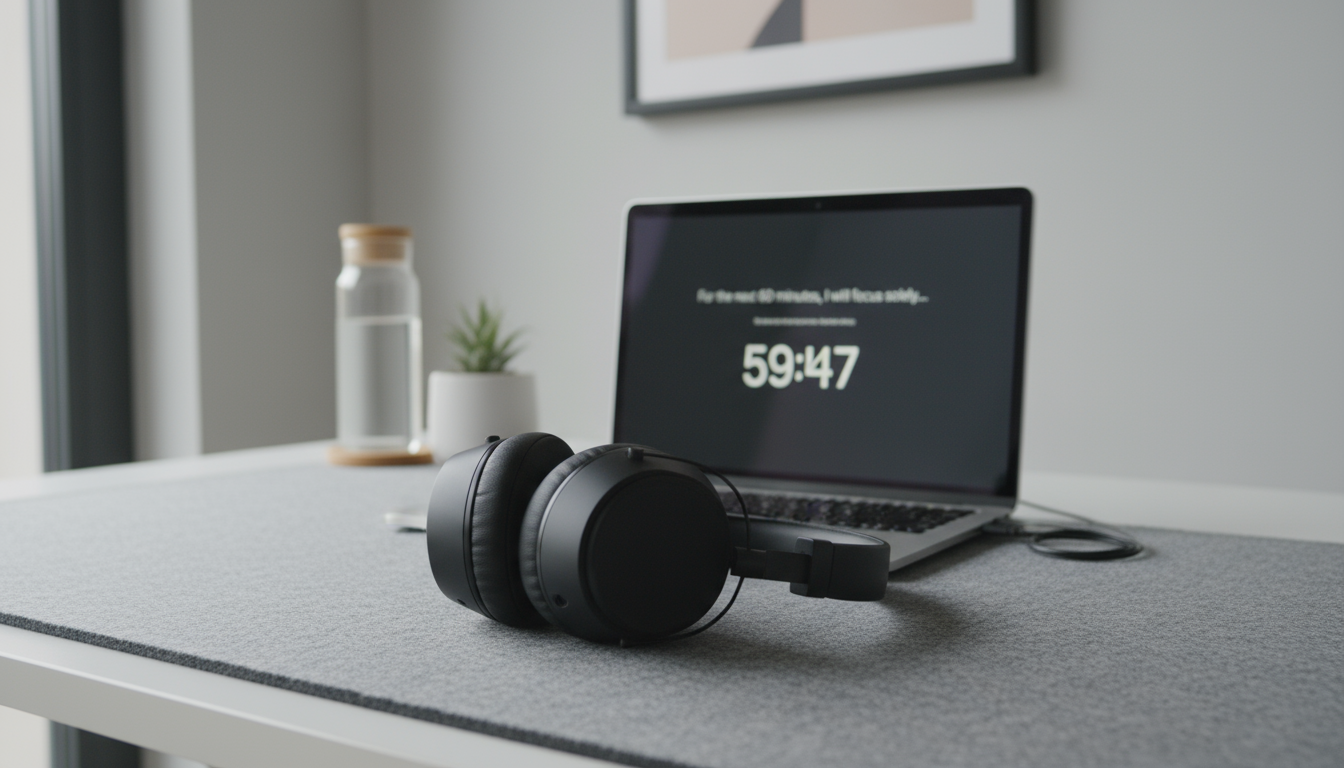
Do you ever feel like you’re spinning a dozen plates at once? You have one browser tab open for work, another for personal email, your phone is buzzing with notifications, and you’re trying to listen to a podcast. At the end of the day, you feel exhausted, but you look back and wonder what you actually accomplished. That feeling of being busy but not productive is a modern epidemic. It’s a form of mental friction that drains your energy and leaves you feeling overwhelmed.
We’ve been told that multitasking is a superpower, a key skill for success in a fast-paced world. But what if that’s a myth? What if the very act of juggling tasks is what’s holding you back from doing your best, most meaningful work? What if the secret to getting more done, with less stress, isn’t about doing more things at once, but about doing one thing at a time?
Welcome to the world of monotasking. This isn’t about slowing down to a crawl. It’s about moving with intention. It’s about giving your full, undivided attention to a single task, seeing it through, and then moving on to the next. It’s a powerful, evidence-based approach to reclaiming your focus and finding clarity in the chaos.
Here at TheFocusedMethod.com, we believe that focus is a skill you can cultivate. It’s not something you’re born with or without. This guide is your starting point. We won’t just tell you to stop multitasking. We’ll show you why it’s so draining and provide practical, simple rituals you can start using today. We’ll explore the mindset shifts that make sustained attention possible and give you the tools to get back on track when life inevitably throws you a curveball. You can trade the feeling of frantic, scattered energy for a sense of calm, deliberate progress. Let’s begin.
📚 Table of Contents
- The Real Cost of Multitasking: Understanding Your Attention
- What is Context Switching?
- The Problem of Cognitive Load
- Unlocking Flow: The Power of Deep Focus
- Your Natural Energy Rhythms
- Building Your Monotasking Practice: Four Essential Rituals
- 1. The Startup Ritual: Prime Your Mind for Focus
- 2. The Deep Work Entry Ritual: Crossing the Threshold
- 3. Break Hygiene: How to Rest and Recharge Effectively
- 4. The Shutdown Ritual: End Your Day with Closure
- Your 20-Minute Monotasking Starter Pack
- Mindset Shifts: The Inner Game of Focus
- Reframe Perfectionism as Progress
- Reduce Friction to Make Focus Easier
- Script Your Reset After Derailment
- Monotasking in Action: Two Worked Examples
- Frequently Asked Questions About Monotasking
- Is it okay to listen to music while working? Isn’t that multitasking?
- But isn’t multitasking a necessary skill in today’s world? My job demands it.
- What if I just don’t feel motivated to start? How does monotasking help with that?
- I’m great at focusing during the day, but I can’t shut my brain off in the evenings. Any advice?
- Your Seven-Day Monotasking Challenge

The Real Cost of Multitasking: Understanding Your Attention
To understand why monotasking is so effective, we first need to look at what happens in your brain when you try to multitask. The human brain, for all its marvels, is not designed to focus on multiple attention-demanding tasks simultaneously. What we perceive as multitasking is actually something else entirely: rapid task-switching.

What is Context Switching?
Imagine you’re writing an important email. Your brain has loaded all the necessary information: the recipient, the key points you need to make, the tone you want to convey. This is your “context.” Suddenly, a notification pops up. It’s a message from a coworker asking about a different project. To answer it, your brain must unload the email context and load a completely new one: the project, your coworker’s question, the relevant files. After you reply, you switch back to the email. But where were you? You have to spend time and energy reloading that original context.
This process is called context switching. It’s the mental jump your brain makes when it moves from one unrelated task to another. Every switch, no matter how brief, comes with a cost. Researchers refer to this as the “switch cost.” It’s the time and mental energy you lose in the transition. While a single switch might only cost you a few seconds, these costs accumulate throughout the day, leading to significant drops in productivity and a huge drain on your mental resources. This is a core reason why the monotasking vs multitasking debate leans so heavily in favor of single-tasking.

The Problem of Cognitive Load
Your brain has a finite amount of processing power at any given moment. Think of it like the RAM in a computer. When you open too many programs, the computer slows down and may even crash. The same thing happens in your mind.
Cognitive load refers to the total amount of mental effort being used in your working memory. When you try to multitask, you are dramatically increasing your cognitive load. You aren’t just holding information for Task A; you’re also trying to hold information for Task B, Task C, and the mental roadmap of switching between them. This overload is why multitasking often leads to more mistakes, lower-quality work, and mental fatigue. You’re not operating at your best because your brain’s resources are spread too thin.

Unlocking Flow: The Power of Deep Focus
Now, let’s consider the opposite of a scattered, multitasking mind. Have you ever been so absorbed in an activity that time seems to disappear? You’re fully immersed, energized, and performing at your peak. This state has a name: flow. It’s a concept popularized by psychologist Mihaly Csikszentmihalyi. Flow is the holy grail of productivity and fulfillment, and it is physiologically impossible to achieve when you are multitasking.
Flow can only happen when you are monotasking. It requires your complete, undivided attention on a single, challenging-but-achievable task. By eliminating distractions and dedicating your mental resources to one thing, you create the conditions for deep engagement. The benefits of monotasking aren’t just about getting more done; they are about accessing a more rewarding and effective way of working and living. This state of deep focus is where creativity flourishes and difficult problems get solved.

Your Natural Energy Rhythms
Finally, it’s important to recognize that your ability to focus isn’t constant throughout the day. Your brain and body operate on natural cycles of energy, often called ultradian rhythms. These are 90-to-120-minute cycles where your energy and alertness rise and then naturally dip. Trying to force yourself to focus during a dip is like swimming against the tide. You’ll exhaust yourself for very little progress.
Multitasking completely ignores these rhythms. It demands constant “on” time, burning through your high-energy phases and deepening the fatigue during your low-energy phases. Monotasking, on the other hand, allows you to work *with* these rhythms. You can dedicate a 90-minute block to deep, focused work, and then take a deliberate, restorative break during the dip. This rhythm of intense focus followed by intentional rest is the key to sustainable productivity, day after day.

Building Your Monotasking Practice: Four Essential Rituals
Understanding the theory is one thing; putting it into practice is another. The transition from habitual multitasking to intentional monotasking is best supported by simple, repeatable routines. These rituals aren’t about adding more to your plate. They are about creating a structure that protects your time and attention. They create clear boundaries between preparation, deep work, rest, and closing down.
Here are four core rituals to help you build a foundation for sustained focus. Start small. You don’t need to implement all of them perfectly from day one. Choose one that feels most helpful and build from there.

1. The Startup Ritual: Prime Your Mind for Focus
How you begin your workday sets the tone for everything that follows. If you jump straight into your inbox, you’re immediately putting yourself in a reactive state, letting others’ priorities dictate your attention. A startup ritual is a 5-to-10-minute buffer that allows you to start the day with intention.
Your ritual could include a few simple steps. First, take a moment to breathe. A few slow, deep breaths can calm your nervous system. Second, briefly review your plan for the day. Don’t look at your entire to-do list. Just identify the one or two most important tasks that require deep focus. This is your “Most Important Task” or MIT. Third, prepare your environment. Close all unnecessary browser tabs and applications. Put your phone on silent and place it out of arm’s reach. Get your water or coffee. This simple act of preparation sends a powerful signal to your brain: “It’s time to focus.”

2. The Deep Work Entry Ritual: Crossing the Threshold
Starting a mentally demanding task can be the hardest part. Procrastination often lurks at the doorway to deep work. An entry ritual is a tiny, consistent routine that helps you overcome that initial resistance and ease into a state of flow.
This ritual can be incredibly short, just one or two minutes. It’s a trigger for your brain. It could be as simple as putting on a specific pair of noise-canceling headphones, starting a specific playlist (instrumental music often works best), or opening a fresh document and writing a single sentence that states your intention, such as: “For the next 60 minutes, I will focus solely on drafting the project proposal.” You could also use a timer. Setting a timer for a specific work block, like 50 minutes, creates a container for your attention. The key is consistency. When you perform the same small actions every time you begin a deep work session, your brain learns the cue and finds it easier to slip into a state of monotasking.

3. Break Hygiene: How to Rest and Recharge Effectively
Breaks are not a sign of weakness; they are a biological necessity for high performance. As we discussed, your brain operates in cycles. Pushing through a natural energy dip leads to burnout and diminishing returns. The goal is not to avoid breaks, but to make them restorative.
Good break hygiene means stepping away from screens. Checking social media or news sites during a break is not true rest. It’s just a different kind of stimulation that keeps your cognitive load high. Instead, during your 5-to-15-minute breaks, stand up and stretch. Look out a window at something distant to rest your eyes. Walk around the room or get a glass of water. Focus on physical movement and sensory experiences. This allows your prefrontal cortex, the part of your brain responsible for executive function and focus, to rest and recharge. When you return to your task, you’ll do so with renewed energy and clarity.

4. The Shutdown Ritual: End Your Day with Closure
Just as important as how you start your day is how you end it. A shutdown ritual helps you transition from work mode to rest mode, preventing tasks and worries from spilling over into your personal time. This is crucial for long-term sustainability and preventing burnout.
At the end of your workday, take 5 to 10 minutes to close the loops. Quickly review what you accomplished. This provides a sense of progress and satisfaction. Then, identify any open tasks and make a quick plan for how you’ll tackle them tomorrow. This “offloads” them from your mind, so you’re not mentally ruminating on them all evening. Finally, physically clean your workspace. Tidy your desk, close your notebooks, and shut down your computer. Say a specific phrase to yourself, like “The workday is now complete.” This ritual creates a clear, psychological boundary, allowing your mind to fully disengage and rest.

Your 20-Minute Monotasking Starter Pack
Feeling overwhelmed by these rituals? Let’s shrink it down. Try this simple 20-minute experiment to experience the benefits of monotasking.
Minute 1-2 (Startup): Choose one, and only one, small task to work on. Close every other tab and program. Put your phone in another room.
Minute 3-17 (Deep Work): Set a timer for 15 minutes. Work only on that single task. If you get distracted, gently guide your attention back to it.
Minute 18-19 (Break): When the timer goes off, stand up. Stretch your arms overhead. Take three slow, deep breaths.
Minute 20 (Shutdown): Write down one sentence about what you will do next (either continue this task later or move to another). Close the document. You’re done with the block.
That’s it. Just 20 minutes. Practice this once a day to build your focus muscle.

Mindset Shifts: The Inner Game of Focus
Building effective rituals is a powerful step, but lasting change also requires an inner shift. Our tendency to multitask is often driven by deep-seated beliefs about productivity, perfection, and even our own capabilities. To truly embrace monotasking, we need to address the thought patterns that keep us scattered.
These aren’t complex psychological overhauls. They are simple, practical “thought tools” you can use to reframe your approach to work and reduce the mental friction that pulls you toward distraction.

Reframe Perfectionism as Progress
Perfectionism is a major driver of multitasking. We have a big, important project, and the thought of doing it perfectly is so intimidating that we procrastinate. To soothe the anxiety of not working on the big task, we fill our time with smaller, less important “productive” activities, like clearing out our inbox or reorganizing files. We feel busy, but we’re avoiding the real work.
The solution is to reframe your goal. Instead of “write the perfect report,” change it to “write a messy first draft for 30 minutes.” Give yourself permission for the first version to be imperfect. The mantra here is “progress, not perfection.” A flawed draft is infinitely more valuable than a perfect idea that never leaves your head. By lowering the stakes, you reduce the fear and make it easier to start. This is a key mental move in the monotasking vs multitasking battle. Monotasking on an imperfect draft will always beat multitasking on “getting ready” to be perfect.

Reduce Friction to Make Focus Easier
Your brain is wired to follow the path of least resistance. If checking social media is easy and starting your deep work is hard, your brain will choose the easier option. The trick is to reverse this. Make focus the easy choice and distraction the hard one.
This is about intentionally designing your environment to reduce friction for the things you want to do. If you want to monotask on a report in the morning, prepare everything the night before. Open the document, find the relevant research files, and leave them open on your desktop. When you sit down, the path of least resistance leads directly into your work. Conversely, add friction to distractions. Log out of social media accounts after each use. Use website blockers during work hours. Move distracting apps to a folder on the last page of your phone’s home screen. Every small bit of friction you add to a distraction gives you a crucial moment to pause and ask, “Is this what I really want to be doing right now?”

Script Your Reset After Derailment
No one is perfectly focused all the time. You will get distracted. You will fall back into old habits of multitasking. This is not a failure; it is part of the process. The most important skill is not avoiding derailment, but learning how to get back on track quickly and without judgment.
Create a simple, non-judgmental “reset script” for yourself. When you realize you’ve gone down a rabbit hole of browsing or have five different tasks open, pause. Take one deep breath. Then, say your script to yourself. It could be something like: “Okay, I got distracted. That’s normal. What is the one thing I need to do right now?” This script interrupts the cycle of frustration and self-criticism. It replaces it with a gentle, compassionate, and action-oriented response. It acknowledges the reality of the situation and immediately pivots you back toward intentionality and monotasking. This simple tool turns moments of distraction from a source of guilt into an opportunity to practice your focus.

Monotasking in Action: Two Worked Examples
Theory and rituals are helpful, but seeing how monotasking plays out in real-world scenarios makes it more tangible. Let’s walk through two common situations where the pull to multitask is strong and see how applying these principles can make a difference.
Example 1: The Tight Deadline at Work
The Scenario: Sarah is a project manager, and a major client report is due by the end of the day. The pressure is on. Her inbox is filling up with “urgent” requests, and her team is messaging her with questions. Her instinct is to try to do everything at once: write the report, answer emails as they come in, and respond to messages instantly to show she’s on top of things.
The Multitasking Trap: If Sarah gives in to this instinct, her morning will be a blur of context switching. She’ll write one paragraph of the report, then switch to answer an email about a different project. Then she’ll respond to a team chat, losing her train of thought on the report. Each switch drains her mental energy. By noon, she’ll have made very little progress on the report, feel stressed and behind, and her work quality on all fronts will be lower. She’ll likely have to stay late to finish a report that is not her best work.
The Monotasking Solution: Sarah decides to try a different approach.
1. Startup Ritual: She takes five minutes to identify her single most important task: “Complete the first draft of the client report.”
2. Reduce Friction & Communicate: She puts an “away” status on her chat application that says, “Deep focus on client report until 11 AM. Will respond then.” She closes her email client completely. This manages others’ expectations and protects her focus block.
3. Deep Work Block: She sets a timer for 90 minutes and works *only* on the report. When she feels the urge to check her email, she gently reminds herself of her goal and refocuses.
4. Restorative Break: After 90 minutes, she takes a 15-minute break. She gets up, walks to the kitchen to get water, and avoids her phone. This recharges her brain.
The Outcome: By 11 AM, Sarah has a solid draft of the report finished. She feels calm and in control. She then dedicates a separate 30-minute block to process her email and messages efficiently. By monotasking, she completes her most important work to a high standard and still addresses her other responsibilities without the constant stress of juggling.

Example 2: The Noisy Home Environment
The Scenario: David works from home and is trying to learn a new software for his job. His kids are home from school, the dog is barking, and there are household chores nagging at his attention. He feels he should be able to handle it all—watch the training video while tidying the kitchen and keeping an ear out for the kids.
The Multitasking Trap: David tries to watch the training video on his laptop while unloading the dishwasher. He has to rewind the video every few minutes because he missed a key point while putting a plate away. The dog barks, and he loses his place completely. He feels frustrated that he isn’t learning and guilty that he isn’t fully present with his family or chores. He’s doing three things at once, but none of them well.
The Monotasking Solution: David realizes this approach isn’t working and decides to structure his time differently.
1. Redefine the Task & Environment: He acknowledges that learning requires deep focus. He can’t do it in the middle of a busy kitchen. He finds a quiet corner, puts on noise-canceling headphones, and decides on a very small goal: “Watch and understand one 15-minute module of the training.”
2. Time Blocking & Communication: He talks to his family. “I need 20 minutes of quiet time to focus on this important training for work. Can you help me by keeping the noise down just for that long?” This sets a clear boundary.
3. Single-Task Immersion: For 20 minutes, he does nothing but watch the video and take notes. He silences his phone and ignores the temptation to open another tab. He fully immerses himself in the learning process.
The Outcome: In that single 20-minute block, David learns more than he did in an hour of distracted multitasking. He feels a sense of accomplishment. When the block is over, he can fully engage with his family and chores without the nagging feeling that he “should” be working. By separating his activities, he gives his full attention to each one, improving both his learning and his home life. This highlights one of the key benefits of monotasking: being more present in every part of your life.

Frequently Asked Questions About Monotasking
As you begin to explore monotasking, questions and obstacles will naturally arise. This is a different way of working, and it can feel counterintuitive at first. Here are answers to some of the most common questions we hear at TheFocusedMethod.com.
Is it okay to listen to music while working? Isn’t that multitasking?
This is a great question that gets to the heart of what defines a “task.” The key distinction is whether an activity requires your cognitive attention. For many people, listening to certain types of music—especially instrumental, ambient, or electronic music without lyrics—can actually support focus. It can help block out distracting background noise and signal to the brain that it’s time to work.
However, if the music has lyrics you’re tempted to sing along to, or if it’s so engaging that you’re actively listening to it, then it becomes a competing task. It starts to consume cognitive resources that could be dedicated to your primary work. The test is simple: does the background sound support your focus or divide it? Experiment with different types of audio, including white noise or silence, to find what works best for you. This isn’t a failure of monotasking; it’s a way of optimizing your sensory environment for deep work.
But isn’t multitasking a necessary skill in today’s world? My job demands it.
This is a very common belief, often fueled by job descriptions that list “ability to multitask” as a required skill. What employers usually mean is that they need someone who can handle multiple projects or responsibilities and can shift between them gracefully. They need someone who is agile and can manage a varied workload, not someone who is literally writing an email and talking on the phone at the exact same time.
The monotasking approach is actually the best way to meet these demands. By focusing intensely on one project for a set block of time, you make more meaningful progress. Then, you can switch your focus completely to the next project. This is “serial monotasking,” not simultaneous multitasking. It allows you to give each responsibility the high-quality attention it deserves, leading to better outcomes and less stress than frantic, parallel switching. You can be a highly effective employee who manages many things by handling them one at a time.
What if I just don’t feel motivated to start? How does monotasking help with that?
A lack of motivation is often a symptom of overwhelm. When a task feels too big, too complex, or too daunting, the natural response is to avoid it. Multitasking is a common avoidance strategy; it lets us feel busy without facing the big, scary task.
Monotasking directly addresses this by forcing you to shrink the task down to a manageable size. The goal is not to “complete the entire project.” The goal is to “work on this one small piece for 15 minutes.” By setting an incredibly small, non-intimidating entry point, you lower the barrier to getting started. Anyone can do something for 15 minutes. Often, that’s all it takes to build momentum. Once you start and make a little progress, motivation often follows. Motivation isn’t something you wait for; it’s something you create with action, and monotasking makes that first action as easy as possible.
I’m great at focusing during the day, but I can’t shut my brain off in the evenings. Any advice?
This is where the Shutdown Ritual becomes so critical. The inability to switch off is often caused by “attention residue”—the lingering thoughts of an unfinished task that follow you after you’ve stopped working on it. When you end your day by abruptly closing your laptop, your brain is left with all these open loops, which it will continue to process in the background.
A deliberate shutdown ritual, as described earlier, is the solution. By taking 5-10 minutes to review your day, capture any lingering to-dos for tomorrow, and tidy your space, you are sending a clear signal to your brain that the work is contained and the day is complete. This process of externalizing your thoughts onto a list or plan allows your mind to let go. It provides the psychological closure needed to transition fully into your evening, so you can rest and recharge properly.
Disclaimer: The information in this article is for educational and informational purposes only and is not intended as medical or psychological advice. Always consult with a qualified health professional for any health concerns or before making any changes to your lifestyle. For authoritative information, please visit recognized sources such as the American Psychological Association or the National Institutes of Health.

Your Seven-Day Monotasking Challenge
You now have a deeper understanding of the monotasking vs multitasking dynamic, the science behind focus, and a toolkit of rituals and mindsets to put into practice. But knowledge is only potential power. Action is where the transformation happens. The greatest benefits of monotasking come from consistent, deliberate practice.
It’s easy to read an article like this, feel inspired, and then fall back into old patterns by tomorrow. So let’s make it real. Let’s make it a small, manageable experiment. I invite you to take on a simple seven-day challenge. Don’t try to change everything at once. The goal is not perfection; it’s practice. The aim is to get a firsthand feel for how intentional, single-task focus can change the quality of your work and your day.
Here are three simple actions to commit to for the next seven days. Choose what feels right, or try all three. Keep it simple, and be kind to yourself as you learn.
1. Practice One “Focus Block” Per Day.
Just one. For the next seven days, schedule a single 25-minute block of time for uninterrupted, monotasked work. You can use the Pomodoro Technique or just a simple timer. During this block, pick your most important task for the day. Close all other tabs. Put your phone in another room. For those 25 minutes, you have only one job. If your mind wanders, gently guide it back. See how much you can accomplish when you give yourself the gift of a single-minded container for your attention.
2. Implement a Five-Minute Shutdown Ritual.
At the end of your workday, before you close your computer, take just five minutes. On a piece of paper or in a document, write down two things: one thing you accomplished today that you’re proud of, and the one task you will start with tomorrow. Then, tidy one thing on your desk. That’s it. This small act of closure can have a massive impact on your ability to disconnect and recharge in the evening.
3. Forgive One Distraction Each Day.
You will get distracted. You will open a tab you didn’t mean to. You will get pulled into a conversation. When it happens, your only task is to notice it without judgment and use your reset script. Say to yourself, “I got distracted. That’s okay. I’m now returning my focus to [your task].” This practice of self-compassion is perhaps the most important focus skill of all. It’s what ensures that one small slip doesn’t derail your entire day.
That’s your challenge. It’s small, it’s achievable, and it’s powerful. For seven days, practice these small acts of intentionality. Notice how you feel. Notice the quality of your work. You have the power to move from a state of constant, low-grade stress to one of calm, focused effectiveness. The journey starts not with a giant leap, but with a single, focused step. You can do this.






